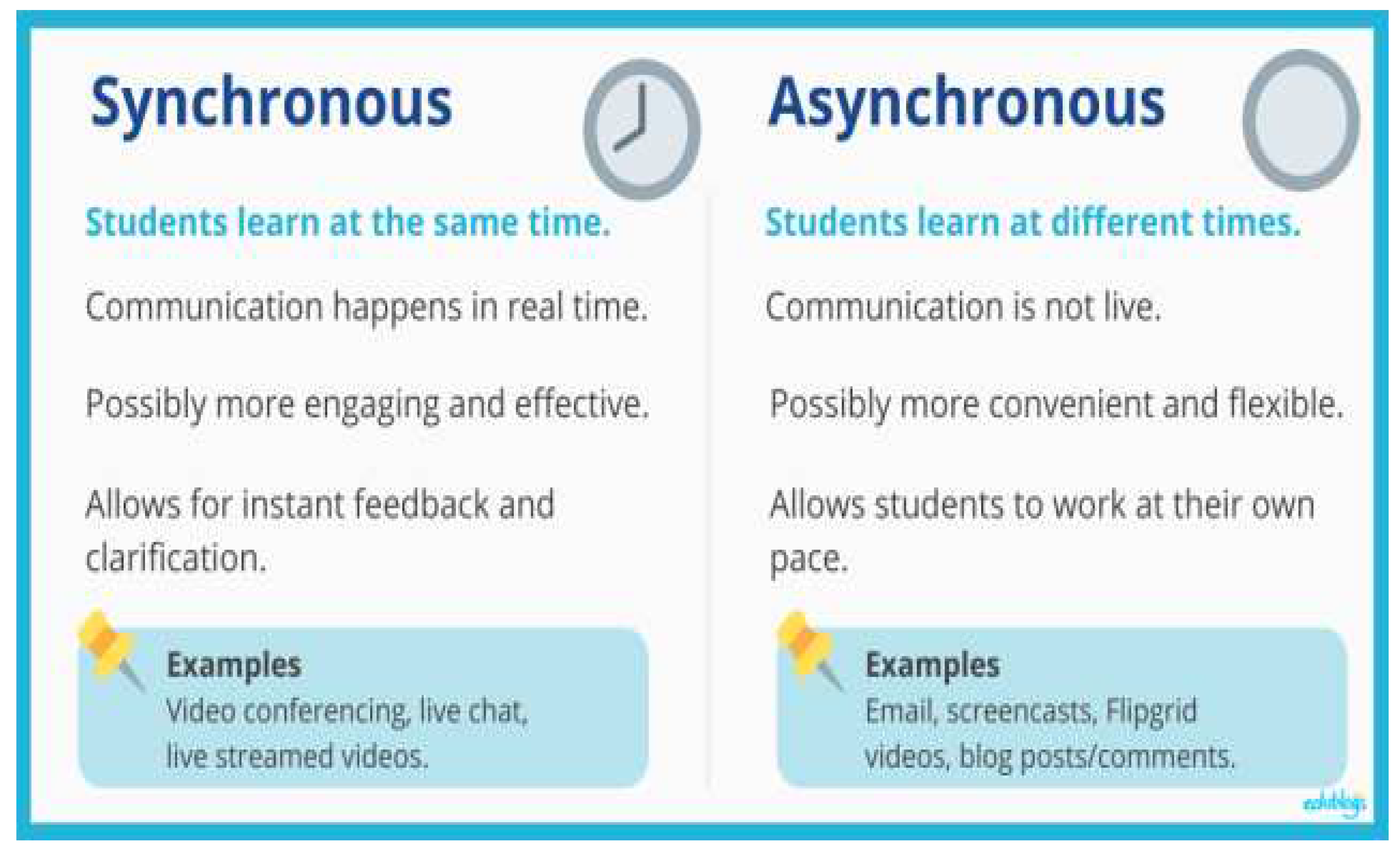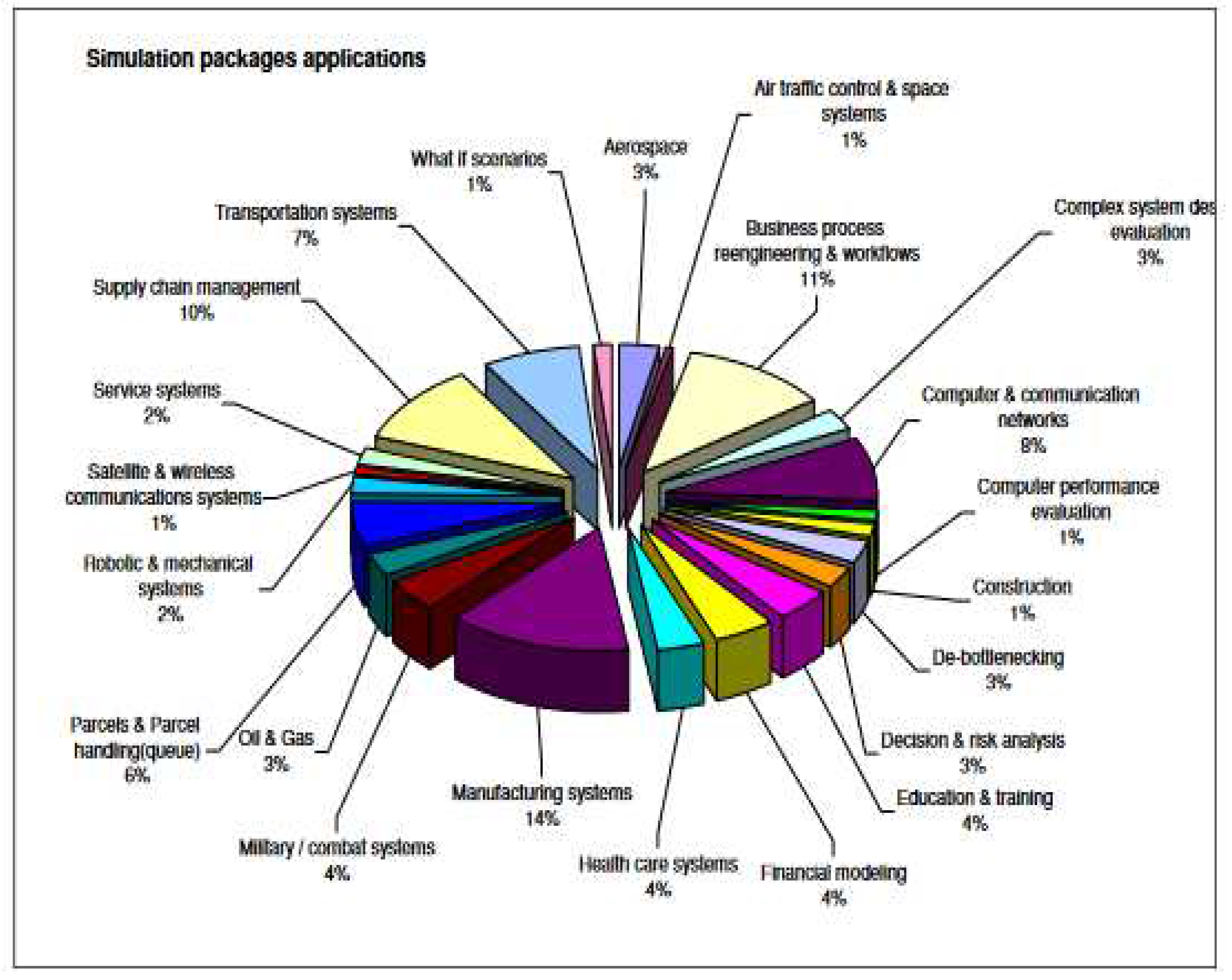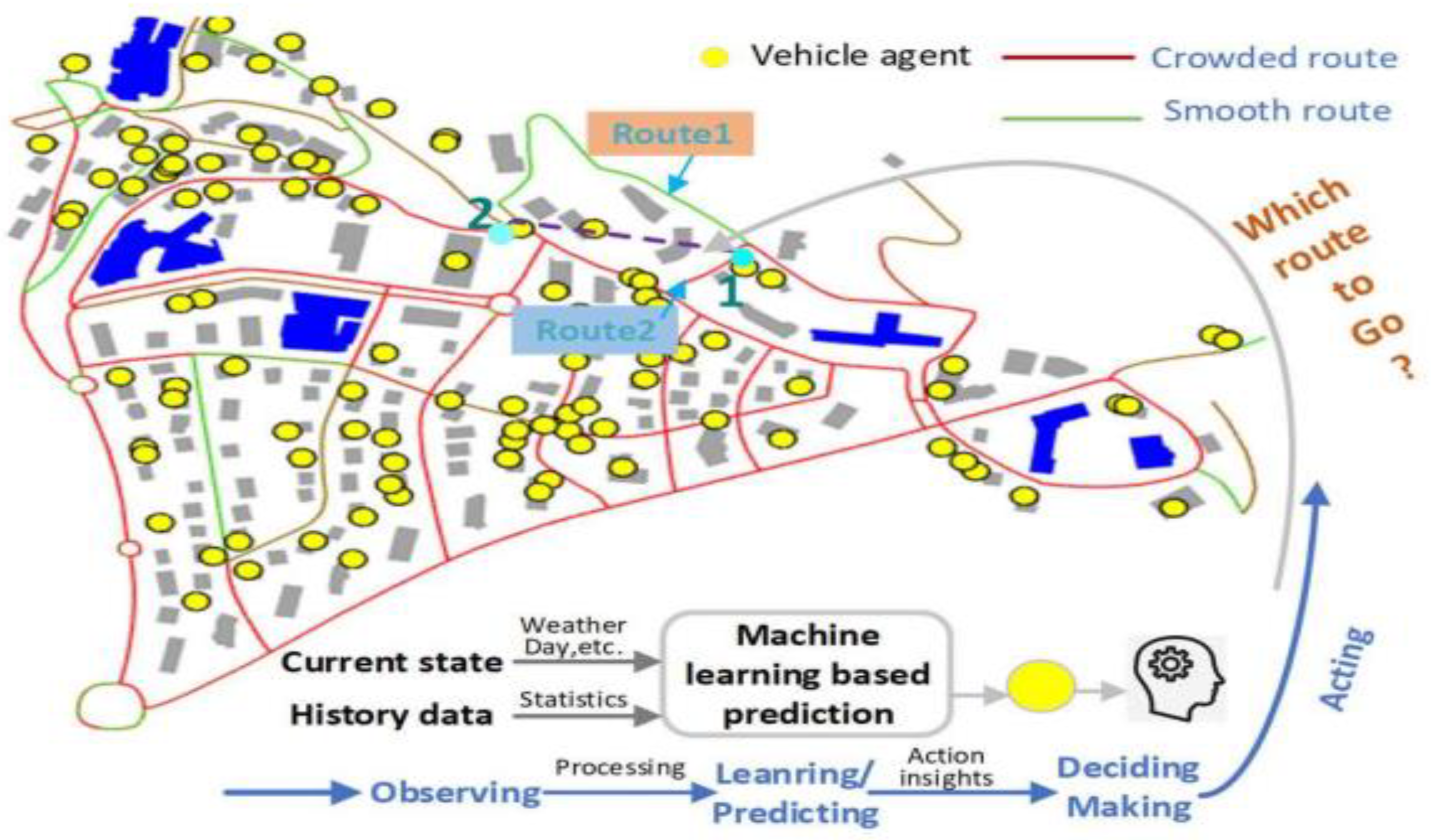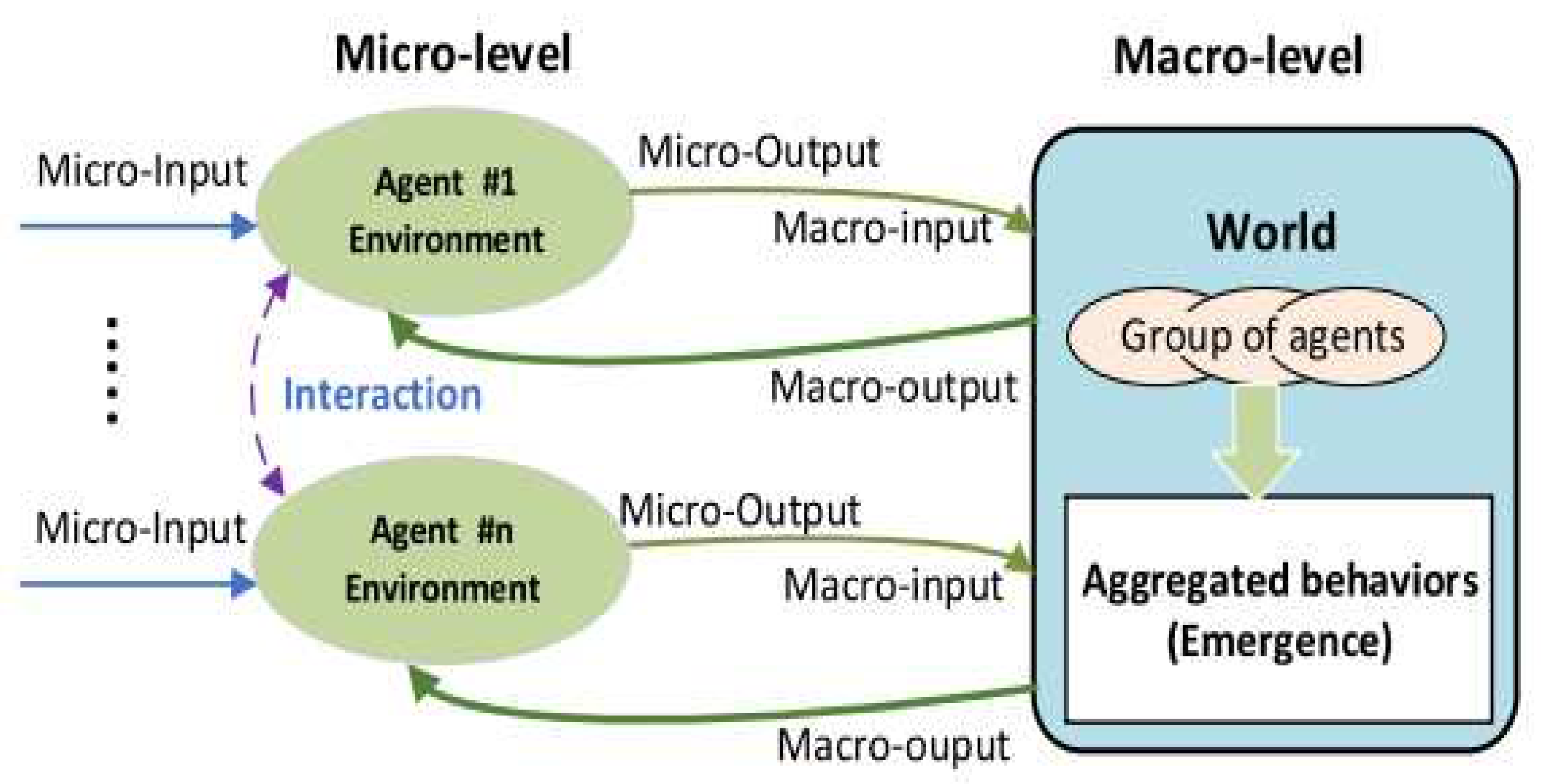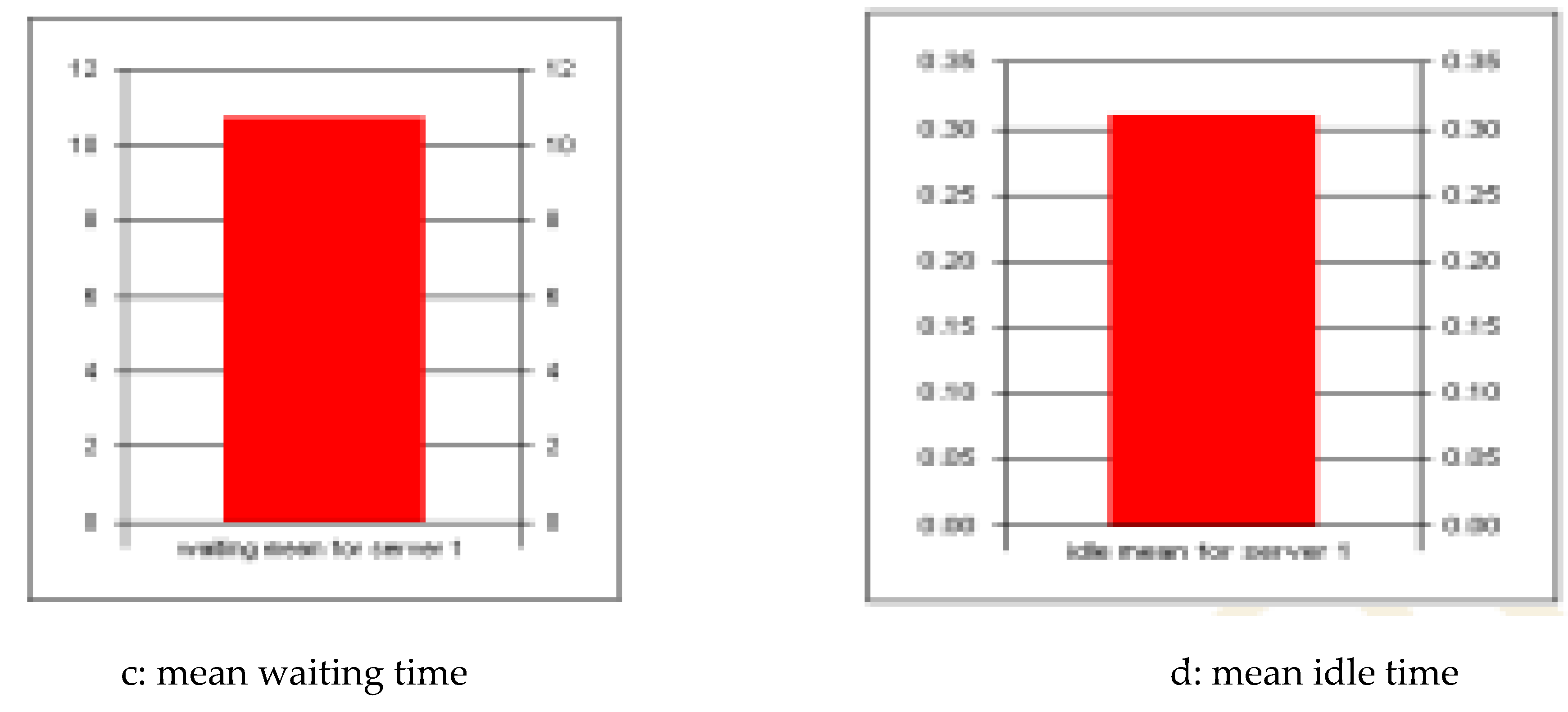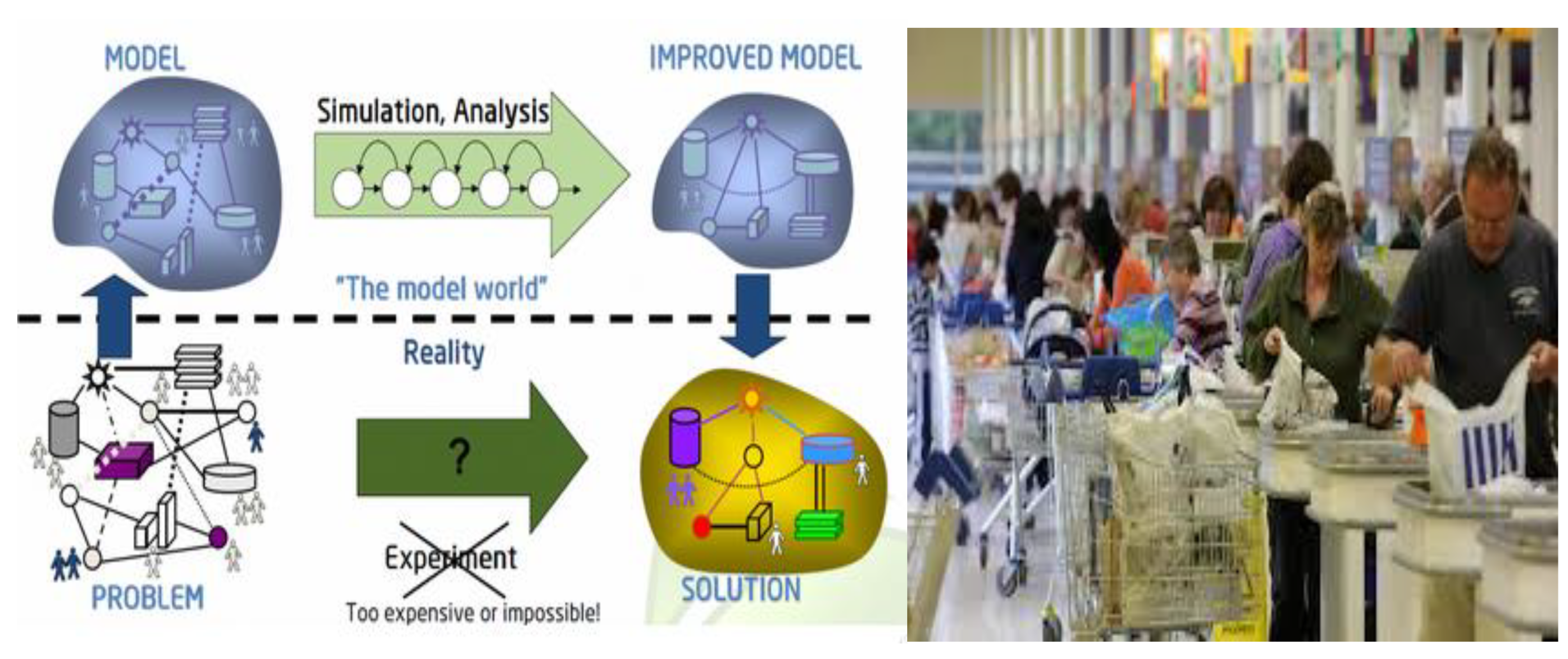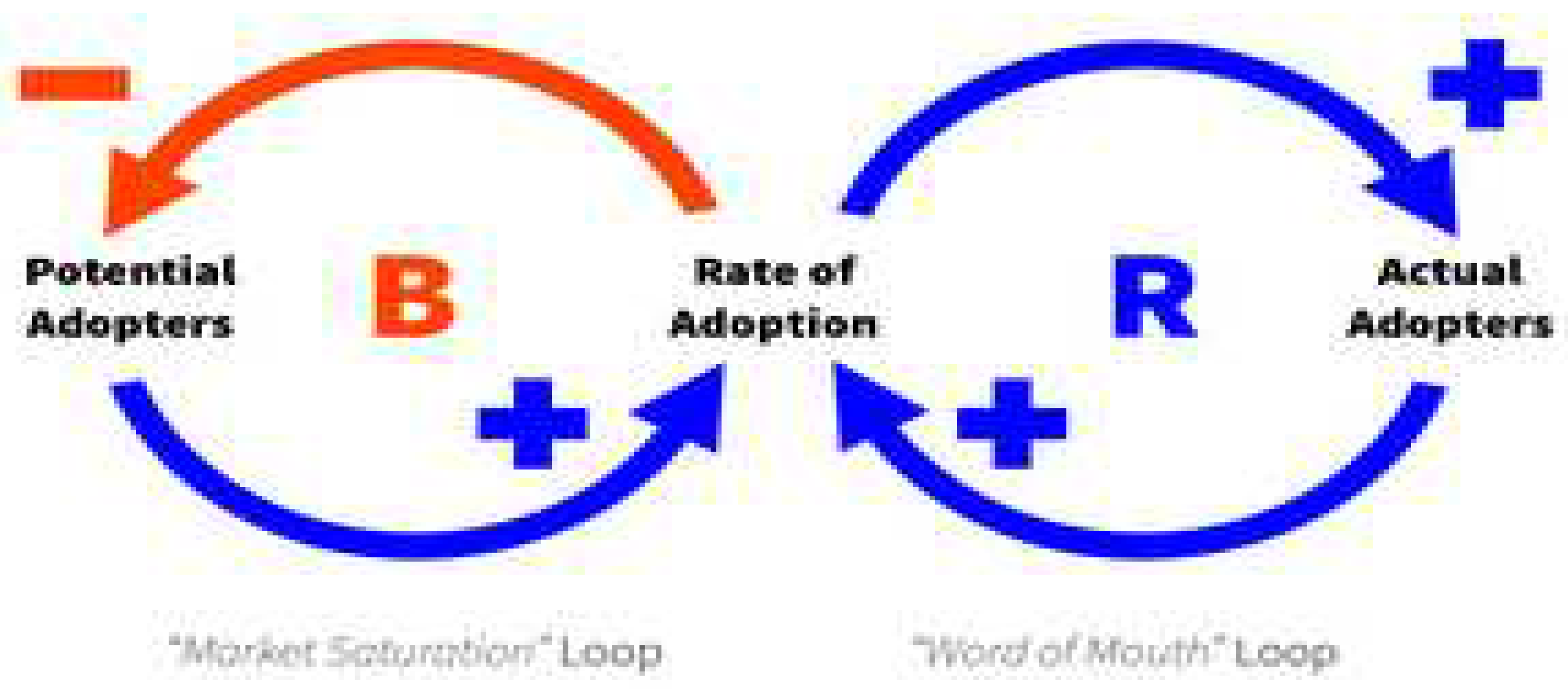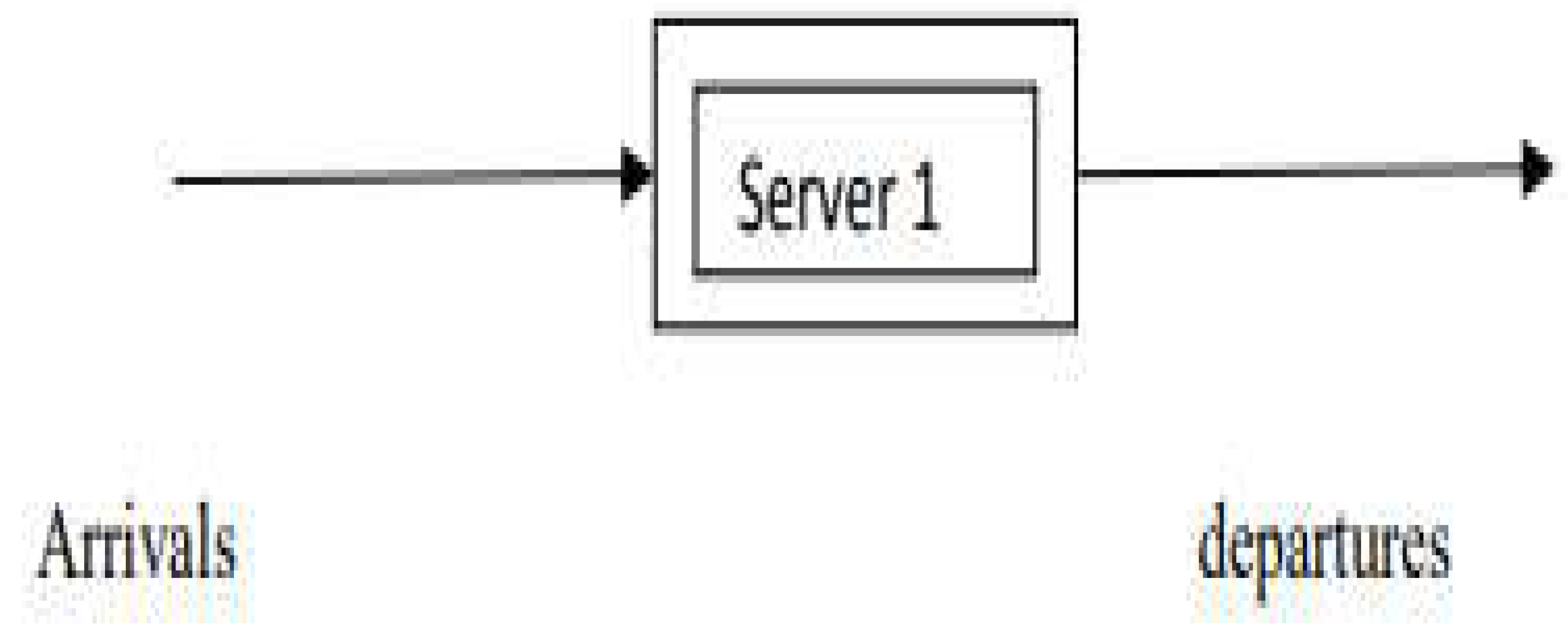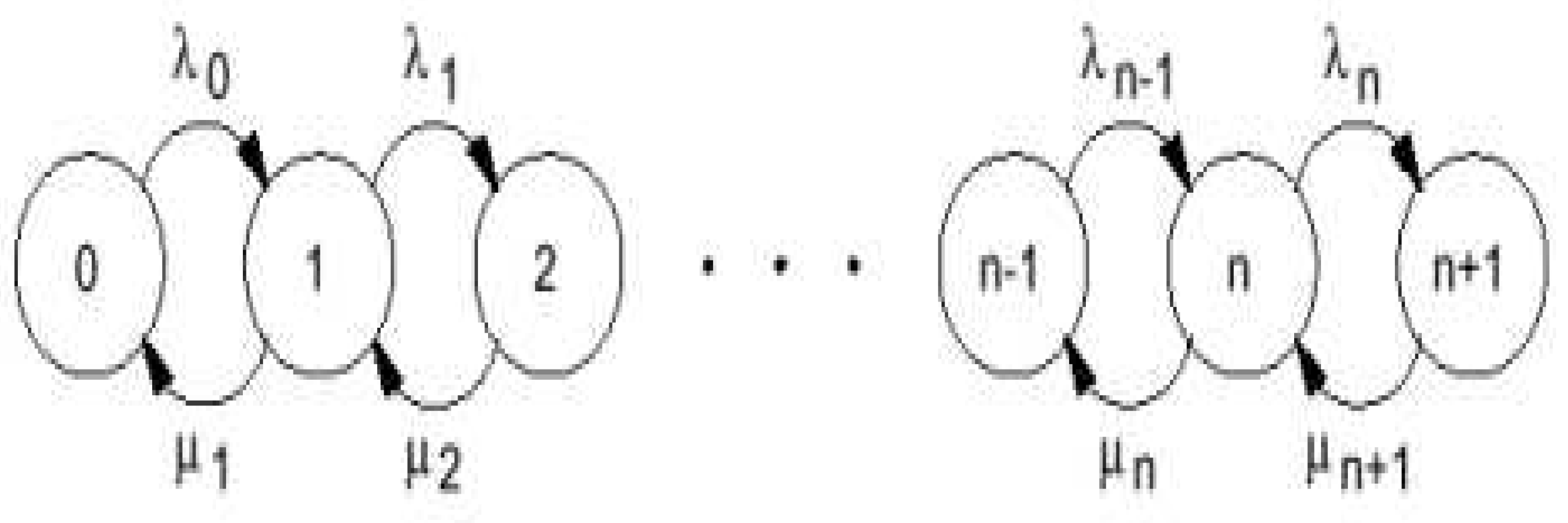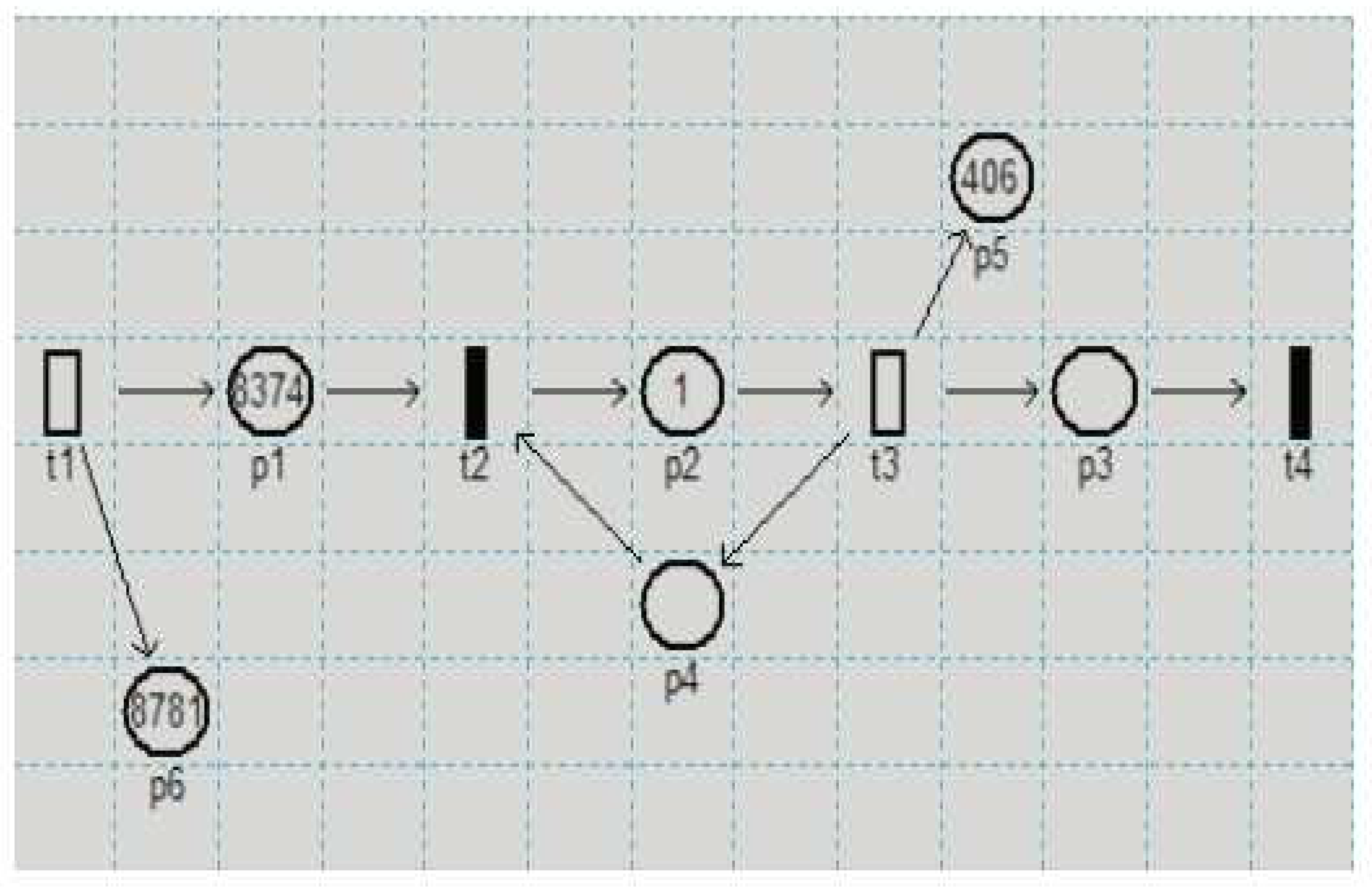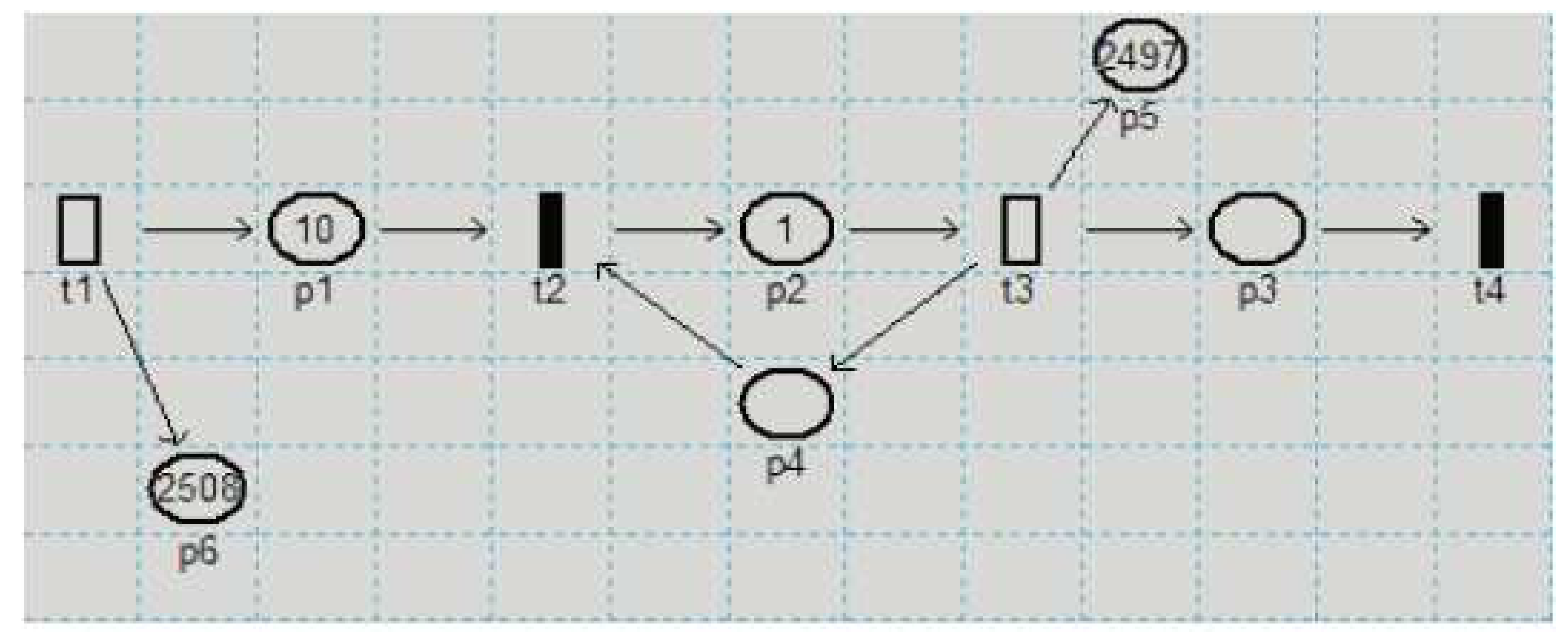I. INTRODUCTION
Decision-makers and designers always use simulation [
1] to assess the effectiveness of a system design and to obtain a better understanding of the anticipated performance of the actual system. Both the design of a new service system and the optimisation of an existing one depend heavily on the performance evaluation process. The performance of a service system can be evaluated at the level of discrete events. It can be used and imitated by developing or building a suitable, legal discrete event simulation mode. A model is an abstraction of the system that is made by making assumptions about how it works [
2]. All the essential components of the system must be included. The model is crucial for testing the system's functionality and the effects of each variable while it is still in the planning stage. Thus, we are motivated by realizations regarding various choices. Broadly speaking, Modelling and Simulation M-S describes how data is developed using models—such as emulators, prototypes, and stimulators—either statically or over time to support administrative or technical choices. "Simulation" and "modelling" are frequently used synonymously.
II. MODELING AND SIMULATION AS AN EMERGING DISCIPLINE
It is to be noted that both diversity and application-oriented [3-12] nature of this novel discipline often results in the challenge to come to a decision on practical needs by model and simulation it is necessary to interpret appropriately them in model terms. Hence, it is not possible to resolve the problem of interpretation for matters reach in content of reality in model terms automatically. This is justifiably dividing the problem into two parts:
description of a knowledge base which is used also for model validation and verification,
choice of the model parameters by calibration and identification techniques.
III. MODELING AND SIMULATION IN PHARMACY EDUCATION
To build a truly immersive simulation in healthcare education, Virtual Patients (VPs) [
13] with coupled interactive conversational abilities are essential. It has been demonstrated that the VP design case, which was informed by research on educational design, redirected the formative design approach to their VR design and continued to enhance it. Three fundamental phases of expert review (PER), human-centered distributed conversation modelling (HCM), and performance data analysis are among the highly precise refinement procedures used in this scenario.
What's more intriguing is that HCM was used as a key strategy to get beyond the drawbacks of the conventional Centralized Conversational Modelling (CCM). Using the three created VPs for the Over the Counter (OTC) simulation for pharmacy, the three phases were explained and evaluation findings [
13] (continuity error rates, unanswered question error rates, and total mistake rates) were shown.
Following the research findings of [
14], it was shown that both suggested delivery and assessment were adequate to asynchronous and synchronous learning frameworks.
Figure 1.
Synchronous-vs-asynchronous-learning (c.f., [
15]).
Figure 1.
Synchronous-vs-asynchronous-learning (c.f., [
15]).
IV. METHODS IN SIMULATION MODELING
A general framework for matching a real-world system to its model is called simulation modelling. To create models, a technique recommends a language type, or "terms and conditions". Currently, three approaches are available:
Modelling discrete events [
25,
26,
27,
28,
29,
30,
31,
32,
33,
34,
35,
36]
The system being modelled, and the goal of the modelling play a major role in the method selection, however the modeler’s expertise frequently has the biggest impact. Look at
Figure 2, where the modeler is choosing the best way to construct a store model. Depending on the nature of the issue, he might create an agent-based model in which consumers are agents impacted by advertisements, communication, and interactions with agents-employees; a process flowchart in which customers are entities and staff are resources; or a feedback structure in which sales are informed about advertisements, quality of service, pricing, customer loyalty, and other factors.
A. System Dynamics
A novel method for comprehending the temporal behaviour of complex systems is system dynamics. It addresses time delays and internal feedback loops that impact the system's overall behaviour. Because system dynamics makes use of feedback loops, stocks, and flows, it differs from previous methods for understanding complex systems. These components aid in explaining the perplexing nonlinearity that even seemingly straightforward systems exhibit.
By capturing interactions followed by the feedback loops (see
Figure 3), the structure of the underlying system is revealed by the causal loop diagram. Therefore, understanding the structure of a system implies the possibility to ascertain the temporal behaviour of the system. More interestingly, the causal loop diagram of the new product introduction may be visualized as follows:
Two feedback loops are depicted in this figure. The positive reinforcement loop (labelled R) on the right shows how word-of-mouth can significantly influence how many people have already accepted a new product. This is because there will be more product references, demos, and reviews. Positive comments should therefore result in increasing sales.
Referred to as "balancing" or negative reinforcement, the second feedback loop on the left is designated as B. Growth is obviously not sustainable, as fewer and fewer potential adopters exist for every adopter who is adopted. The two feedback loops operate concurrently, albeit at distinct times and possibly with varying intensities. As a result, one would anticipate rising sales in the first few years and falling sales in the following years.
B. Discrete Event Modelling
Any system functioning can be modelled as a discrete sequence of temporal events (time-dependent events) using a discrete-event simulation (DES).Every event occurs at a precise moment in time to document a shift in the underlying system's condition. It should be noted that the simulation can instantly leap in time from one occurrence to the next. Another option to event-based simulation is process-based simulation, in which all system action is connected to a distinct process, which is usually simulated by a thread in the simulation program.
It is widely agreed that the Three-Phase approach permits simulating
parallelism, whilst keeping away from deadlock”. However, Three-Phase must scan through the schedule in search of bound activities, and then it becomes more slower because of scanning through all conditional activities. Having said that, Three-Phase is commonly used in distributed systems and databases [
47].
Figure 4.
Simulation packages applications (c.f., [
47]).
Figure 4.
Simulation packages applications (c.f., [
47]).
C. Scope of agent-based modelling and simulation paradigm ABMS
Scope, or the domain in which an ABMS tool may be able to carry out modelling and simulation scenarios, is one of its most essential characteristics [
48]. To simulate dynamic large-scale complex systems and observe emergent behaviour, ABMS is becoming more and more popular in a variety of scientific fields, including ecology, climate change, economics, biology, agriculture, sociology, social sciences, route planning, and many other STEM (science, technology, engineering, and mathematics) fields [
49,
50,
51]. One way to conceptualize complex systems is as collections of interacting agents or things. Agents can take the form of people, businesses, institutions, animals, or any other entity with the intention of achieving a particular objective.
Figure 5.
Applying ML in ABM for route planning; an agent intends to move from point 1 to 2 and determines the route based on prediction from Machine Learning, ML (c.f., [
52]).
Figure 5.
Applying ML in ABM for route planning; an agent intends to move from point 1 to 2 and determines the route based on prediction from Machine Learning, ML (c.f., [
52]).
It is well known that ABMs are specifically applied in the case of modelling complex phenomena, where active entities interact among themselves with certain inherent attributes to devise agency relationships, thereby facilitating automated reasoning [
53]. This is because libraries and tools have been adopted to help scientists and professionals construct such models for a while.
The primary goal is to build simulations of intricate systems that develop from several decentralized modules interacting as a collection of artefacts. The elements that exist in the environment and have a set of qualities that are subject to change over time are referred to as individual objects or agents. Agents in biological systems can take the form of independent, discrete spatial objects, such as cells, that can be part of a continuum or discrete arrangement [
49].
Knowing a political or economic system in a social context involves more than just knowing the people that make up the system. Understanding how the people interact with one another and how the outcome can be more than the sum of its parts is also necessary [
54].
The two main problem-solving strategies are demonstrated by systems or units that are studied using the ABMS concept, which is ideally matched to the social science objectives [55, 56]. In theory, ABMS tools help practitioners and scholars examine how a system's micro-level characteristics, limitations, and rules affect its macroscopic behaviour.
Figure 6.
Architecture of ABM (c.f., [
52]).
Figure 6.
Architecture of ABM (c.f., [
52]).
V. simulation of a single server queueing model
In the real world, single-server queues [
57] are arguably the most common type of queue. In many contexts, such as commerce (e.g., sales clerks), industry (e.g., manufacturing lines), and transportation (e.g., queues), one comes across a line with a single server. Thus, it is very helpful to be able to simulate and analyze the activity of a single server queue. Since both arrivals and services are Poisson (or random) processes, the statistical distribution of both the inter-arrival times and the service times follows an exponential distribution. M/M/1 represents a single server with an infinite calling population and an unlimited queue capacity.
Given the arrival rate and service rate, several straightforward correlations can be constructed for various performance indicators due to the exponential distribution's mathematical character. This is lucky since many queuing scenarios can be approximated by an M/M/1 queuing model. The (M/M/1) model is a simulation that was developed to mimic the behaviour of a single server queuing system with an infinite number of clients and FCFS queuing discipline. To see how each parameter affects the others, the necessary performance metrics will be approximated, and the inter-arrival and service times will be adjusted.
Figure 7 depicted the model layout, and
Figure 8 shows the transition diagram for it (using Markov representation).
A birth-death process can be used to simulate such a system, with each state denoting the total number of users. The system can exist in an infinite number of states, such as state 0 (no users), state 1 (one user), state 2 (two users), etc., because it has an infinite queue and an infinite population. Since there is an endless population and there will never be a full queue, the mean arrival rate, or birth rate, or λ, remains constant across all states. The Mean service Rate is denoted by and expected length of the line of customers in systems that have come and have been served. It is to be noted that the necessary condition for a queue to be stable is . Substantially, the strengthen condition for the stability of any underlying queueuing system is characterized by .
After building the simulation model, programming and implementation, the following cases were evaluated to indicate the required parameters [
59]:
Figure 9.
A case study for single server model,
(c.f., [
59])
Figure 9.
A case study for single server model,
(c.f., [
59])
There is opportunity for debate and discussion over the reliability of the performance metrics thanks to the modelling and simulation technique. To what extent are they realistic? What is the extent of their confidence? Which extrapolation and interpretation fit the presumptive model? Should a different model have been employed? Under what circumstances is the network's ideal model? As a potent scientific tool, simulation is used in the service process to assess an appropriate model or gauge the impact of making modifications to an already-operated system.
Theoretically, it is important to highlight that modelling and simulation techniques benefit decision makers, planners, and managers alike. This is because they can assist in making the best decisions regarding the system and in assessing the performance of each configuration based on the possibility of minimising costs by minimising idle time, waiting time, or both. Before attempting these models in real life to determine which scenario yields the best answer, computer simulation enables us to test these models virtually, altering each aspect every time and displaying all these consequences on the system.
Our key conclusion is that, to describe the behaviour of the system and assess its effectiveness, all researchers should utilize the modelling approach. The results will closely resemble the measured values when the proper parameter values are used. Even in the worst scenario, when it yields inaccurate data, it aids in the creative knowledge of the system's behaviour and functionality. The fundamental performance modelling method used in the article can be used to hardware capacity studies, the process of assessing system performance, needs for data gathering, and a wide range of new service network design possibilities.
Here comes another simulation approach. The
queue was imitated by Petri network simulator [
60]. Both theoretical and simulated surveys for these queues have been undertaken. We have the following two cases:
Case 1 - The
Figure 10 visualizes a model of
queue simulation for population of 1000 for
. The allocated simulation is 882.652 seconds.
The following table provides theoretical and simulation for case 2
|
1 |
|
|
|
| Theoretical |
0.100 |
0.090 |
1.111 |
| Simulation |
0.097 |
0.097 |
0.996 |
| Error % |
3.491 |
7.704 |
10.395 |
Following several undertaken simulations for the queue by using the concept of Petri nets by comparing the values of , similar values with a small error were obtained. The error does not exceed 15%. This confirms the accuracy of our research of the queue.
Comparing the time execution for different values of it is concluded that the increase of impacts the time of execution of the simulation to be reduced. Observing case 2, for Petri network model corresponding to the queueing system, the value This value contradicts the stability requirement of the underlying queueing system. Moreover, the value translates that the underlying queueuing system drifted away from the stability phase into the instability phase. Based upon the theoretical results, the defined default values for the mean arrival rate, and the mean service rate, , after performed simulation, we have reached the value , which supports both validity and accuracy of the proposed simulator.
VI. CONCLUSION AND PROSPECT
Significant uses of modelling and simulation approaches for complex systems, like life support systems and queueing systems, are highlighted in the current review study. Because modelling and simulation have so many different applications, the search never ends. The challenge and the research race undoubtedly never end since they greatly encourage the exploration of additional novel findings that expand the boundaries of modelling and simulation's usefulness in the interpretation of challenging real-world issues.
References
- P. Jeffries P. “The NLN Jeffries simulation theory”, Lippincott Williams & Wilkins; 2021.
- C.Bäckström and P. Jonsson , “ A framework for analyzing state-abstraction methods. Artificial Intelligence”, 2022;302:103608. [CrossRef]
- S. Abar S, et al., “ Agent Based Modelling and Simulation tools: A review of the state-of-art software.”, 2017, Computer Science Review, 1;24:13-33. [CrossRef]
- M. Hoveskog , et al., “ Education for Sustainable Development: Business modelling for flourishing”, 2018, Journal of Cleaner Production;172:4383-96. [CrossRef]
- D. Karagiannis, “Conceptual modelling methods: the AMME agile engineering approach”, 2018, In Domain-Specific Conceptual Modelling, (pp. 3-21). Springer, Cham.
- KP.Senthil and V.Punitha, “An overview of nonwoven product development and modelling of their properties.”, 2017, Journal of Textile Science and Engineering;7(4):1-5. [CrossRef]
- SM. Goetz and ZD. Deng, “The development and modelling of devices and paradigms for transcranial magnetic stimulation”, 2017, International Review of Psychiatry, Mar 4;29(2):115-45. [CrossRef]
- M.Straka , et al., “ Evaluating the Waste Incineration Process for Sustainable Development through Modelling, Logistics, and Simulation”, Polish Journal of Environmental Studies,2018,1;27(6). [CrossRef]
- AM. Belostotsky et al., “Contemporary problems of numerical modelling of unique structures and buildings”, 2017, International Journal for Computational Civil and Structural Engineering;13(2):9-34. [CrossRef]
- DC. Wynn and PJ. Clarkson, “Process models in design and development”, 2018, Research in engineering design;161-202. [CrossRef]
- HY.SO, et al., “Simulation in medical education”, 2019, Journal of the Royal College of Physicians of Edinburgh;49(1):52-7. [CrossRef]
- M. Adib-Hajbaghery and N. Sharifi, “ Effect of simulation training on the development of nurses and nursing students' critical thinking: A systematic literature review”, 2017, Nurse education today;50:17-24. [CrossRef]
- J.Jackson and S.Park , “Creating intelligent virtual patients for simulation-based pharmacy education through human-centred conversation modelling.”, 2020,International Journal of Smart Technology and Learning;2(2-3):96-114. [CrossRef]
- DM. D'Arcy, et al., “Using in silico process simulation tools in pharmacy education: Considerations for pivoting to online learning”, 2020, Pharmacy Education;20(2):124-35. [CrossRef]
- Timmanson, “synchronous-vs-asynchronous-learning”, 2021. Online source available at: https://timmanson.wordpress.com/2021/01/18/synchronous-vs-asynchronous-learning/.
- V. de Gooyert , “Developing dynamic organizational theories; three system dynamics-based research strategies”, 2019, Quality & Quantity;53(2):653-66. [CrossRef]
- F. Ciccarello F, et al., “Quantum collision models: open system dynamics from repeated interactions”, 2022, Physics Reports;954:1-70. [CrossRef]
- HA.Akkermans and KE. Van Oorschot , “Relevance assumed: a case study of balanced scorecard development using system dynamics”, 2018,In System dynamics (pp. 107-132). Palgrave Macmillan, London.
- O.Krol and V. Sokolov V, “Modelling carrier system dynamics for metal-cutting machines”, 2018, In 2018 International Russian Automation Conference (RusAutoCon) (pp. 1-5). IEEE.
- JJ.Cardiel-Ortega , et al., “ Development of a system dynamics model based on Six Sigma methodology”, 2017, Ingeniería e investigación;37(1):80-90. [CrossRef]
- IP. Guma IP, et al., “ Food security indicators for subsistence farmers sustainability: A system dynamics approach”, 2022,In Research Anthology on Strategies for Achieving Agricultural Sustainability (pp. 413-435). IGI Global.
- M. Bastan M, et al., “A Simulation Model of Mobile Banking Acceptance by Bank Customers Using the System Dynamics Approach”, 2021,Journal Archive;19. [CrossRef]
- A. Konyalioglu and B. Zafeirakopoulos, “ An integrated model of system dynamics and fuzzy cognitive mapping approach for waste management in Turkey”, 2019, GLOBAL NEST JOURNAL;21(4). [CrossRef]
- S. Bruni , et al., “ State-of-the-art and challenges of railway and road vehicle dynamics with multibody dynamics approaches”, 2020, Multibody System Dynamics;49(1):1-32. [CrossRef]
- BP.Zeigler , et al., “ Theory of modelling and simulation: discrete event & iterative system computational foundations”, 2018, Academic press.
- GA.Wainer, “ Discrete-event modeling and simulation: a practitioner’s approach”, 2017, CRC press.
- GA.Wainer and PJ.Mosterman, “Discrete-event modeling and simulation: theory and applications”, CRC press.
- X. Zhang, “Application of discrete event simulation in health care: a systematic review”, 2018, BMC health services research.;18(1):1-1. [CrossRef]
- A. Greasley and C.Owen , “Modelling people’s behaviour using discrete-event simulation: a review”, 2018, International Journal of Operations & Production Management.
- P.Gittins , et al., “Discrete event simulation in livestock management”,2020, Journal of Rural Studies;78:387-98. [CrossRef]
- I.Ucar, et al., “ Discrete-Event simulation for R”, 2017, arXiv preprint arXiv:1705.09746.
- A.Greasley and JS.Edwards, “Enhancing discrete-event simulation with big data analytics: A review”, 2021, Journal of the Operational Research Society;72(2):247-67. [CrossRef]
- N.Prajapat and A.Tiwari , “A review of assembly optimisation applications using discrete event simulation”, 2017, International Journal of Computer Integrated Manufacturing.;30(2-3):215-28. [CrossRef]
- A.Kampa , et al., “ Discrete event simulation method as a tool for improvement of manufacturing systems”, 2017, Computers;6(1):10. [CrossRef]
- RM.Fujimoto ,et al., “Parallel discrete event simulation: The making of a field”, 2017, In 2017 Winter Simulation Conference (WSC) (pp. 262-291). IEEE.
- Cocopans’ , et al., “ NetSquid, a discrete-event simulation platform for quantum networks, 2020, arXiv e-prints:arXiv-2010.
- S. Abar , et al., “ Agent Based Modelling and Simulation tools: A review of the state-of-art software”, 2017, Computer Science Review;24:13-33. [CrossRef]
- BD. Marshall, “Agent-based modelling. Systems science and population health.”,2017;15:87.
- S.Namany , et al., “Sustainable food security decision-making: an agent-based modelling approach”, 2020, Journal of Cleaner Production;255:120296. [CrossRef]
- E.Silverman et al., “Situating agent-based modelling in population health research”, 2021, Emerging Themes in Epidemiology;18(1):1-5. [CrossRef]
- VM. de Souza , et al., “ Assessing the eco-effectiveness of a solid waste management plan using agent-based modelling”, 2021, Waste Management;125:235-48. [CrossRef]
- CH. Chen and R. Venkatachalam, “ Agent-based modelling as a foundation for big data. Journal of Economic Methodology”, 2017;24(4):362-83. [CrossRef]
- L.Zhuo and D.Han , “Agent-based modelling and flood risk management: a compendious literature review”, 2020,Journal of Hydrology;591:125600. [CrossRef]
- E.Silverman et al., “ Situating agent-based modelling in population health research.”, 2021, Emerging Themes in Epidemiology;18(1):1-5. [CrossRef]
- Focus Group, “Digital Twin, Simulation-Based Decision Support Systems”, 2020, Online available at: https://focus-grp.com.
- WRKSHP, “The best Tools For Your Next Innovation Workshop”, 2019. An Online Source available at: https://wrkshp.tools.
- E.Abu-Taieh and A. El Sheikh, “ Commercial simulation packages: a comparative study”, 2007, International Journal of Simulation;8(2):66-76.
- S. Abar, et al., “Agent Based Modelling and Simulation tools: A review of the state-of-art software”, 2017, Computer Science Review;24:13-33. [CrossRef]
- R.J. Allan, “Survey of agent based modelling and simulation tools” , 2010,Technical Report: DL-TR-2010-007, Version 1.1, Science and Technology Facilities Council (STFC) Daresbury Laboratory, Daresbury, Warrington, WA4 4AD.
- C.M. Macal, “ Everything you need to know about agent-based modelling and simulation”, 2016,J. Simul. 10, 144–156. [CrossRef]
- A. Marvuglia, et al., “ A return on experience from the application of agent-based simulations coupled with life cycle assessment to model agricultural processes”,2017, J. Cleaner Prod. 142 (4);1539–1551. [CrossRef]
- W.Zhang, et al., “ Synergistic Integration Between Machine Learning and Agent-Based Modeling: A Multidisciplinary Review”, 2021, IEEE Transactions on Neural Networks and Learning Systems.
- D.A. Robertson, “Agent-based modeling toolkits: NetLogo, repast, and swarm”,2005, book & resource reviews, Acad. Manag. Learn. Educ. 4; 525–527.
- R. Axelrod and L. Tesfatsion, “A guide for newcomers to agent-based modeling in the social sciences”, 2005. Available Online: http://www2.econ.iastate.edu/tesfatsi/GuidetoABM.pdf.
- M.J. North, et al., “ Managing Business Complexity: Discovering Strategic Solutions with Agent-Based Modeling and Simulation”, 2007,Oxford University Press.
- E. Pignotti, et al.,. “ Supporting distributed simulation experiments using a semantic workflow framework & virtual machines”, 2009, in: Proceedings of the 5th IEEE International Conference on e-Science.
- ST. Aljebori, “Simulation approach to model queueing problems”, 2011, 3rd International Union of Arab Statisticians Scientific Conference, Amman, Jordan.
- KC. Jones, “Manufacturing Simulation Using Virtual Reality”, 1992,MSc thesis in Industrial Engineering , University of Washington.
- F. Hosseinpour and H. Hajihosseini, “Importance of Simulation in Manufacturing”, 2009,World Academy of Science, Engineering and Technology.
- E. Kamceva, et al., “Modelling of queues by using of Petri net simulator”, 8th Conference on Informatics and Information Technology with International Participation (CIIT 2011): 121-124.
|
Disclaimer/Publisher’s Note: The statements, opinions and data contained in all publications are solely those of the individual author(s) and contributor(s) and not of MDPI and/or the editor(s). MDPI and/or the editor(s) disclaim responsibility for any injury to people or property resulting from any ideas, methods, instructions or products referred to in the content. |
© 2024 by the authors. Licensee MDPI, Basel, Switzerland. This article is an open access article distributed under the terms and conditions of the Creative Commons Attribution (CC BY) license (http://creativecommons.org/licenses/by/4.0/).
